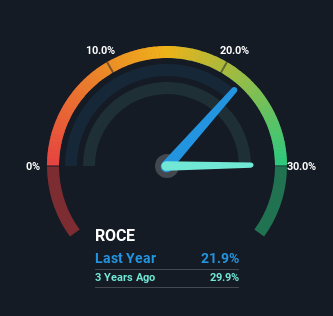- United States
- /
- Household Products
- /
- NYSE:CLX
Clorox (NYSE:CLX) Could Be At Risk Of Shrinking As A Company

What financial metrics can indicate to us that a company is maturing or even in decline? More often than not, we'll see a declining return on capital employed (ROCE) and a declining amount of capital employed. Trends like this ultimately mean the business is reducing its investments and also earning less on what it has invested. In light of that, from a first glance at Clorox (NYSE:CLX), we've spotted some signs that it could be struggling, so let's investigate.
Return On Capital Employed (ROCE): What Is It?
For those that aren't sure what ROCE is, it measures the amount of pre-tax profits a company can generate from the capital employed in its business. The formula for this calculation on Clorox is:
Return on Capital Employed = Earnings Before Interest and Tax (EBIT) ÷ (Total Assets - Current Liabilities)
0.22 = US$852m ÷ (US$5.9b - US$2.0b) (Based on the trailing twelve months to December 2023).
So, Clorox has an ROCE of 22%. On its own that's a fantastic return on capital, though it's the same as the Household Products industry average of 22%.
See our latest analysis for Clorox

Above you can see how the current ROCE for Clorox compares to its prior returns on capital, but there's only so much you can tell from the past. If you're interested, you can view the analysts predictions in our free analyst report for Clorox .
The Trend Of ROCE
There is reason to be cautious about Clorox, given the returns are trending downwards. To be more specific, the ROCE was 29% five years ago, but since then it has dropped noticeably. And on the capital employed front, the business is utilizing roughly the same amount of capital as it was back then. This combination can be indicative of a mature business that still has areas to deploy capital, but the returns received aren't as high due potentially to new competition or smaller margins. So because these trends aren't typically conducive to creating a multi-bagger, we wouldn't hold our breath on Clorox becoming one if things continue as they have.
On a side note, Clorox's current liabilities have increased over the last five years to 34% of total assets, effectively distorting the ROCE to some degree. Without this increase, it's likely that ROCE would be even lower than 22%. Keep an eye on this ratio, because the business could encounter some new risks if this metric gets too high.
The Bottom Line On Clorox's ROCE
All in all, the lower returns from the same amount of capital employed aren't exactly signs of a compounding machine. Despite the concerning underlying trends, the stock has actually gained 14% over the last five years, so it might be that the investors are expecting the trends to reverse. Either way, we aren't huge fans of the current trends and so with that we think you might find better investments elsewhere.
On a separate note, we've found 4 warning signs for Clorox you'll probably want to know about.
If you want to search for more stocks that have been earning high returns, check out this free list of stocks with solid balance sheets that are also earning high returns on equity.
New: AI Stock Screener & Alerts
Our new AI Stock Screener scans the market every day to uncover opportunities.
• Dividend Powerhouses (3%+ Yield)
• Undervalued Small Caps with Insider Buying
• High growth Tech and AI Companies
Or build your own from over 50 metrics.
Have feedback on this article? Concerned about the content? Get in touch with us directly. Alternatively, email editorial-team (at) simplywallst.com.
This article by Simply Wall St is general in nature. We provide commentary based on historical data and analyst forecasts only using an unbiased methodology and our articles are not intended to be financial advice. It does not constitute a recommendation to buy or sell any stock, and does not take account of your objectives, or your financial situation. We aim to bring you long-term focused analysis driven by fundamental data. Note that our analysis may not factor in the latest price-sensitive company announcements or qualitative material. Simply Wall St has no position in any stocks mentioned.
About NYSE:CLX
Clorox
Engages in the manufacture and marketing of consumer and professional products worldwide.
Average dividend payer with moderate growth potential.
Similar Companies
Market Insights
Community Narratives



